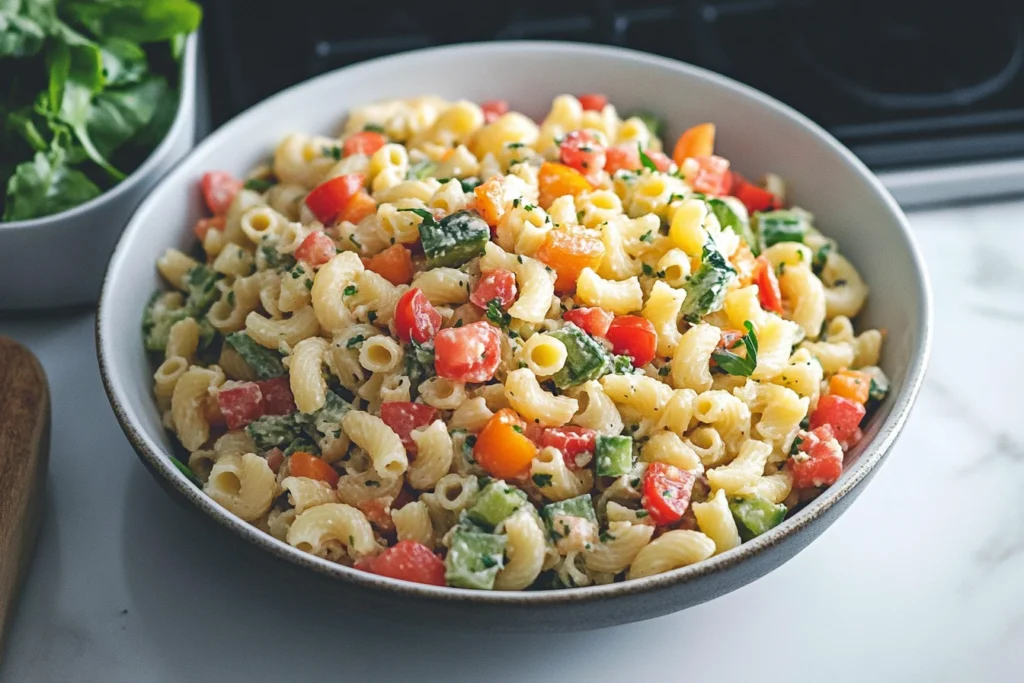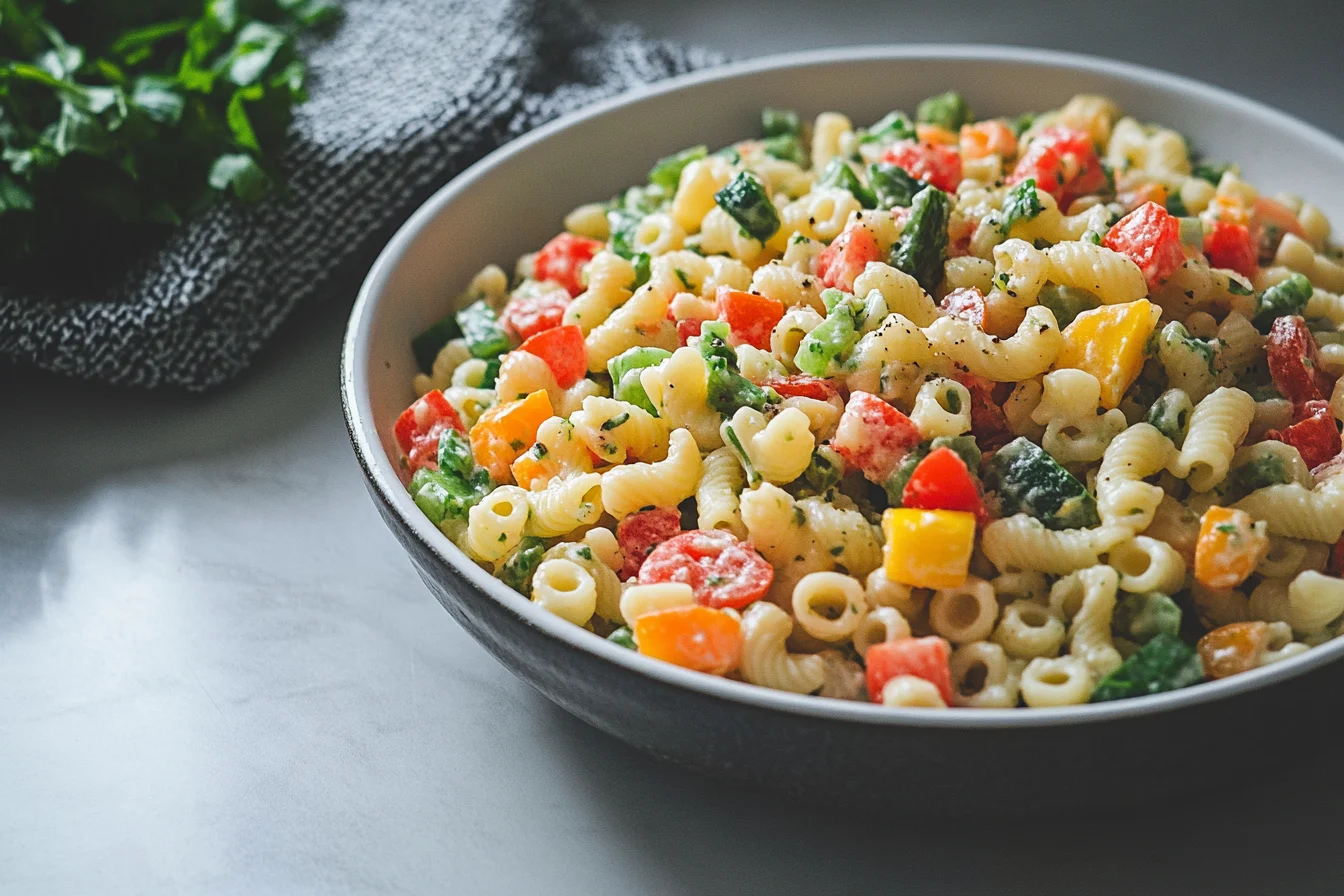Ditalini pasta, meaning “small thimbles” in Italian, is a short, tube-shaped pasta that is beloved for its versatility. Recognized by its tiny, hollow structure, it’s a staple in Italian cooking and has made its way into kitchens worldwide. Its compact size makes it ideal for dishes like soups, stews, and even pasta salads.

Ditalini’s unique texture allows it to absorb flavors beautifully, making it a favorite in hearty meals.
The Meaning of “Ditalini” and Its Culinary Significance
The word ditalini translates to “small thimbles,” a nod to its tubular shape. In Italian cooking, pasta shapes are chosen not just for aesthetics but for their practicality in absorbing and holding flavors. Ditalini’s small, hollow form ensures that every bite is packed with sauce, broth, or dressing.
Characteristics of Ditalini Pasta
Shape, Size, and Texture
- Shape: Short, cylindrical tubes.
- Size: About 3–5 mm in length, making it smaller than penne or rigatoni.
- Texture: Smooth, with a slight roughness on some varieties to help grip sauces.
Ditalini’s size and structure make it perfect for dishes where uniformity and ease of eating are essential.
How Ditalini Differs from Other Pasta Types
While many pasta types share a tubular shape, ditalini stands out due to its small size and versatility:
- Compared to Penne or Rigatoni: Much smaller, making it better suited for soups.
- Compared to Orzo: While similar in size, ditalini’s hollow shape allows it to hold more liquid or sauce.
Common Uses for Ditalini Pasta
Soups and Broths: A Classic Pairing
Ditalini is often referred to as “soup pasta” due to its prominence in brothy dishes like minestrone or pasta e fagioli. Its ability to cook evenly in liquid makes it a go-to choice for these recipes.
Salads, Stews, and Beyond
In addition to soups, ditalini shines in cold pasta salads and hearty stews. Its size allows it to mix seamlessly with vegetables, proteins, and dressings, creating cohesive and flavorful dishes.
Why Ditalini Pasta Is Loved Worldwide
Versatility and Ease of Cooking
Ditalini is incredibly versatile. Whether you’re preparing a quick weeknight meal or an elaborate feast, it adapts effortlessly to various recipes. Additionally, its short cooking time makes it a practical choice for busy cooks.
The Perfect Pasta for Comfort Dishes
Few pasta shapes evoke comfort like ditalini. Its compact size makes it easy to eat, while its ability to hold rich sauces and broths ensures each bite delivers a satisfying burst of flavor.
How to Cook Ditalini Pasta
Cooking ditalini pasta is simple, but achieving the perfect al dente texture requires attention to detail. Follow these steps to ensure your pasta turns out delicious every time:
Preparing Ditalini: Step-by-Step Guide
Boiling the Perfect Al Dente Pasta
- Choose Your Pot: Use a large pot to give the pasta ample room to move, preventing it from sticking.
- Add Water: Fill the pot with water, using approximately 4–6 quarts for every pound of pasta.
- Bring to a Boil: Heat the water over high heat until it reaches a rolling boil.
- Add Salt: Generously salt the water—about 1–2 tablespoons. The salted water enhances the pasta’s flavor.
- Cook the Pasta: Add the ditalini and stir occasionally. Follow the package instructions for cooking time, usually 8–10 minutes.
- Taste Test: Check for al dente—firm to the bite but not hard.
- Drain and Rinse (Optional): Drain the pasta in a colander. For hot dishes, do not rinse, as the starch helps sauces adhere. For cold salads, rinse with cold water to stop the cooking process.
Salting the Water: Tips and Tricks
Salting the water is a crucial step. Use enough salt to make the water taste slightly briny. This not only seasons the pasta but also enhances the flavors of your entire dish.
Pro Tip: Add salt only after the water has started boiling to prevent slowing the boiling process.
Popular Recipes Featuring Ditalini Pasta
Ditalini pasta shines in a variety of recipes, from hearty soups to creamy casseroles. Below are three popular dishes to try:
Classic Minestrone Soup with Ditalini
Minestrone is a quintessential Italian soup where ditalini plays a starring role. Here’s a quick overview:
- Ingredients: Ditalini pasta, vegetables (carrots, celery, zucchini), beans, tomatoes, and vegetable broth.
- Preparation:
- Sauté vegetables until tender.
- Add broth, tomatoes, and seasonings, then simmer.
- Cook ditalini separately and add just before serving to avoid overcooking.
This dish is perfect for chilly days and pairs well with crusty bread.
Ditalini Pasta Salad with Fresh Vegetables
Ditalini pasta salad is a refreshing and versatile dish that’s great for potlucks or meal prep.
- Ingredients: Cooked ditalini, cherry tomatoes, cucumbers, olives, feta cheese, and a vinaigrette dressing.
- Preparation:
- Toss all ingredients in a large bowl.
- Chill in the refrigerator for 30 minutes to let the flavors meld.
Customization Tip: Add grilled chicken or chickpeas for extra protein.
Creamy Ditalini Mac and Cheese
Upgrade your comfort food game with this creamy ditalini mac and cheese recipe.
- Ingredients: Ditalini pasta, butter, flour, milk, cheddar cheese, and parmesan.
- Preparation:
- Make a roux by melting butter and whisking in flour.
- Gradually add milk, stirring until thickened.
- Stir in cheese until melted, then mix with cooked ditalini.
- Serving Suggestion: Top with breadcrumbs and bake for a crispy finish.
Pairing Ditalini with Sauces and Ingredients
Best Sauces for Ditalini: Creamy, Tomato-Based, and More
Ditalini pairs well with a variety of sauces:
- Creamy Sauces: Alfredo, cheese, or garlic cream sauces coat the pasta beautifully.
- Tomato-Based Sauces: Marinara and arrabbiata add a tangy, robust flavor.
- Broth-Based Sauces: Light broths, such as chicken or vegetable, complement ditalini in soups.
Adding Protein: Chicken, Beans, and Tofu
For a complete meal, incorporate protein into your ditalini dishes:
- Chicken: Grilled or shredded chicken pairs well with creamy sauces or salads.
- Beans: Cannellini or kidney beans are perfect for soups like pasta e fagioli.
- Tofu: Add cubed tofu to stir-fries or soups for a vegetarian-friendly option.
Enhancing Flavor with Herbs and Spices
Fresh herbs and spices elevate ditalini pasta dishes. Here are some popular choices:
- Herbs: Basil, parsley, thyme, or oregano add an aromatic touch.
- Spices: Crushed red pepper flakes, garlic powder, or black pepper enhance savory notes.
Variations, Storage, and Fun Facts About Ditalini Pasta
Variations and Substitutes for Ditalini Pasta
Ditalini’s small, tubular shape makes it unique, but there are several variations and substitutes for those who prefer alternative options or need to accommodate dietary restrictions.
Whole Wheat and Gluten-Free Ditalini
For a healthier or allergy-friendly option, consider these varieties:
- Whole Wheat Ditalini:
- Contains more fiber and nutrients.
- Offers a slightly nuttier flavor and firmer texture.
- Perfect for hearty soups and salads where sturdiness is beneficial.
- Gluten-Free Ditalini:
- Made with rice, quinoa, or corn flour.
- Ideal for individuals with gluten sensitivities or celiac disease.
- Tastes similar to traditional ditalini, though it may cook faster, so watch the timing.
Other Small Pasta Shapes That Work as Substitutes
If ditalini is unavailable, these pasta shapes can serve as substitutes:
- Orzo: A rice-shaped pasta that works well in soups and salads.
- Small Shells: Their cupped shape is perfect for holding sauces.
- Elbow Macaroni: Slightly larger but still a good option for creamy dishes.
- Acini di Pepe: Tiny, bead-like pasta great for brothy soups.
These alternatives maintain the charm of small pasta dishes while offering slight variations in texture and appearance.
How to Store Ditalini Pasta Properly
Proper storage extends the shelf life of your ditalini pasta and preserves its quality for future use.
Storing Dry Ditalini for Long Shelf Life
Dry ditalini pasta has a long shelf life if stored correctly:
- Storage Tips:
- Keep in an airtight container to prevent exposure to moisture.
- Store in a cool, dry place away from direct sunlight.
- Shelf Life:
- Typically lasts 1–2 years if unopened.
- Use within 6–12 months after opening for optimal freshness.
Freezing and Reheating Cooked Ditalini
Cooked ditalini can be frozen for convenient meal prep:
- Freezing:
- Toss cooked pasta with a small amount of olive oil to prevent sticking.
- Portion into airtight freezer bags or containers and label with the date.
- Reheating:
- Thaw in the refrigerator overnight.
- Reheat in boiling water for 1–2 minutes or warm it directly in a sauce or soup.
These methods ensure your pasta retains its texture and flavor even after storage.
Ditalini Pasta Around the World
Though ditalini is an Italian classic, it has found its way into diverse culinary traditions worldwide.
Regional Dishes Featuring Ditalini
- Italy:
- Pasta e Fagioli: A beloved Italian bean soup with ditalini as a key ingredient.
- Minestrone: A hearty vegetable soup where ditalini adds texture.
- United States:
- Macaroni Salad: Ditalini is often used as a substitute for elbow macaroni.
- Chicken Noodle Soup: A unique twist using ditalini instead of traditional noodles.
- Mediterranean:
- Pasta and Chickpea Stews: Ditalini combines with chickpeas, tomatoes, and spices for a satisfying dish.
How Ditalini Is Marketed Internationally
Ditalini is marketed under various names and brands, often highlighting its versatility:
- In Italian packaging, it’s labeled as Ditalini or Tubetti.
- Some international brands call it “soup pasta” to emphasize its traditional use in broths.
- Gluten-free and whole-grain varieties are increasingly popular in health-conscious markets.
Fun Facts and Trivia About Ditalini Pasta
Ditalini pasta has an intriguing history and quirky facts that make it even more appealing:
The Role of Ditalini in Italian Culinary Culture
- Traditional Roots:
- Often referred to as “poor man’s pasta,” ditalini was used in dishes that stretched simple ingredients into filling meals.
- Cultural Significance:
- In Southern Italy, ditalini is a comfort food often associated with family gatherings and holidays.
Unique Ditalini Dishes You May Not Know About
- Ditalini Risotto: A creamy dish where ditalini replaces rice for a pasta-inspired risotto.
- Ditalini Stir-Fry: Used in fusion cuisine to create a pasta stir-fry with vegetables and soy sauce.
- Dessert Ditalini: In some regions, sweetened ditalini dishes are made with sugar, cinnamon, and milk for a unique dessert.
More FAQs
- What does “ditalini” mean?
It means “small thimbles” in Italian, referencing its shape. - What is ditalini best used for?
It’s perfect for soups, stews, pasta salads, and creamy dishes. - Can I substitute ditalini with another pasta?
Yes, orzo, small shells, and elbow macaroni are good substitutes. - How long does it take to cook ditalini?
Typically 8–10 minutes for al dente texture. - Is ditalini gluten-free?
Traditional ditalini contains wheat, but gluten-free options are available. - Can I freeze cooked ditalini?
Yes, toss it with olive oil and freeze in airtight containers. - What sauces pair well with ditalini?
Creamy, tomato-based, and light broth sauces work wonderfully. - Is ditalini healthy?
It can be, especially if made from whole wheat or paired with nutritious ingredients. - How do I prevent ditalini from getting mushy in soup?
Cook it separately and add just before serving. - What makes ditalini unique?
Its small, tubular shape and versatility in absorbing flavors.

Ditalini Pasta Recipe
Equipment
- Large pot
- Skillet
- Wooden Spoon
- Strainer
- Knife
- Cutting Board
Ingredients
Main Ingredients
- 2 cups ditalini pasta
- 2 tablespoons olive oil
- 1 medium onion diced
- 3 cloves garlic minced
- 1 14.5-ounce can diced tomatoes
- 1 teaspoon dried basil
- 1 teaspoon dried oregano
- to taste salt and black pepper
- 1/4 cup grated Parmesan cheese for garnish
- 2 tablespoons fresh parsley chopped, for garnish
Instructions
- Bring a large pot of salted water to a boil. Cook the ditalini pasta according to the package instructions until al dente. Drain and set aside.
- In a skillet, heat the olive oil over medium heat. Add the diced onion and sauté for 5-7 minutes, until softened.
- Stir in the minced garlic and cook for another minute until fragrant.
- Add the diced tomatoes, dried basil, dried oregano, salt, and black pepper. Simmer the sauce for 10 minutes, stirring occasionally.
- Toss the cooked ditalini pasta with the tomato sauce until well coated. Adjust seasoning as needed.
- Serve warm, garnished with grated Parmesan cheese and fresh parsley. Enjoy!
